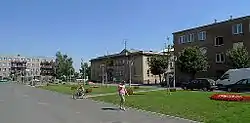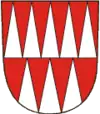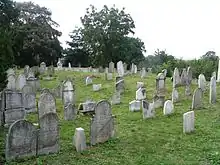Osoblaha
Osoblaha (Czech pronunciation: [ˈosoblaɦa]; German: Hotzenplotz; Yiddish: האָצ׳פּלאָץ (Hotz'plotz, Hots'plots); Polish: Osobłoga) is a municipality and village in Bruntál District in the Moravian-Silesian Region of the Czech Republic. It has about 1,100 inhabitants. It lies in the Osoblažsko microregion. The Osoblaha River flows through the municipality.
Osoblaha | |
|---|---|
 Main square | |
 Flag  Coat of arms | |
 Osoblaha Location in the Czech Republic | |
| Coordinates: 50°16′N 17°43′E | |
| Country | |
| Region | Moravian-Silesian |
| District | Bruntál |
| First mentioned | 1233 |
| Government | |
| • Mayor | Antonín Rous |
| Area | |
| • Total | 25.79 km2 (9.96 sq mi) |
| Elevation | 220 m (720 ft) |
| Population (2020-01-01[1]) | |
| • Total | 1,125 |
| • Density | 44/km2 (110/sq mi) |
| Time zone | UTC+1 (CET) |
| • Summer (DST) | UTC+2 (CEST) |
| Postal code | 793 99 |
| Website | www |
Osoblaha municipality is situated in the northern part of the microregion, and is the final stop of the narrow-gauge railway.
Administrative parts
Village of Osoblaha is the only part of the municipality. In the area of Osoblaha lies former village of Studnice, which is abandoned since 1971.[2]
Etymology
The Czech name of the village came from Latin names of two local rivers, Osoblaha and Planá, in Latin Ossa and Plavia.[3]
The German name "Hotzenplotz" was derived from German Holzen Platz (literally wooden place) and has its origin in oak forests in the area.[3] It served the German writer Otfried Preussler for naming his famous children's book character of "Hotzenplotz the Robber".
History
The first mention of Osoblaha dates back to 1233. The village gained the town rights in 1251, which opened the way for its subsequent economical development.[4]
According to the Austrian census of 1910 the town had 2,853 inhabitants, 2,759 of whom had permanent residence there. The census asked people for their native language: 2,754 (99.8%) declared themselves to be German-speaking, though this includes most Yiddish-speaking Jews, who were not allowed to enter Yiddish as a separate language. The main religious groups were Roman Catholics with 2,779 (97.4%), followed by Jews with 58 (2%).[5]
From 1938 to 1945 it was one of the municipalities in Sudetenland. World War II halted the small-town prosperity of Osoblaha (Osoblaha had a population of nearly 5,000 in the 1930s). Although Osoblaha was the first town in the Czech lands to be liberated by Soviet troops on 22 March 1945, the bitter fighting caused the destruction of 90% of all buildings. In 1960 the town lost its town status.[4]
Sights

The most important monument is the Jewish cemetery. The cemetery is unique in the Czech Republic because of the gravestones ("matzeva") designed in the "Silesian style". This type of tombstones typically uses ornamentation dating back as far as 1694. Remains of former town fortifications from the 16th century can be seen in the town.
Other monument is the St. Nicholas Church, which together with the empire fountain on the square is one of the last monuments to attest the Osoblaha's original architectural style.
In the 1870s, the owners of the sugar refinery in Osoblaha wanted a railway connection for purposes of trade.[6] From financial point of view, the best alternative was a connection to the railway network in neighbouring Prussia. However, the government in Vienna refused this on political and military grounds. On 14th December 1898 a narrow gauge railway line from Třemešná was opened. The railway today serves as a touristic attraction.
Notable people
- Berthold Englisch (1851–1897), Austrian chess master
- Oskar Gutwinski (1873–1932), mountaineer and ski pioneer
See also
References
- "Population of Municipalities – 1 January 2020". Czech Statistical Office. 2020-04-30.
- "Studnice". zanikleobce.cz (in Czech). Retrieved 2020-09-26.
- "Pověsti". mikroregion-osoblazsko.cz (in Czech). Mikroregion Osoblažsko. Retrieved 2020-09-26.
- "Dějiny". osoblaha.cz (in Czech). Obec Osoblaha. Retrieved 2020-09-26.
- Ludwig Patryn (ed): Die Ergebnisse der Volkszählung vom 31. Dezember 1910 in Schlesien, Troppau 1912.
- Schreier, Pavel (2004). Zrození železnic v Čechách, na Moravě a ve Slezsku. Praha: Baset. p. 242. ISBN 80-7340-034-0.
- "Úvodní strana". osoblaha.cz (in Czech). Obec Osoblaha. Retrieved 2020-09-26.